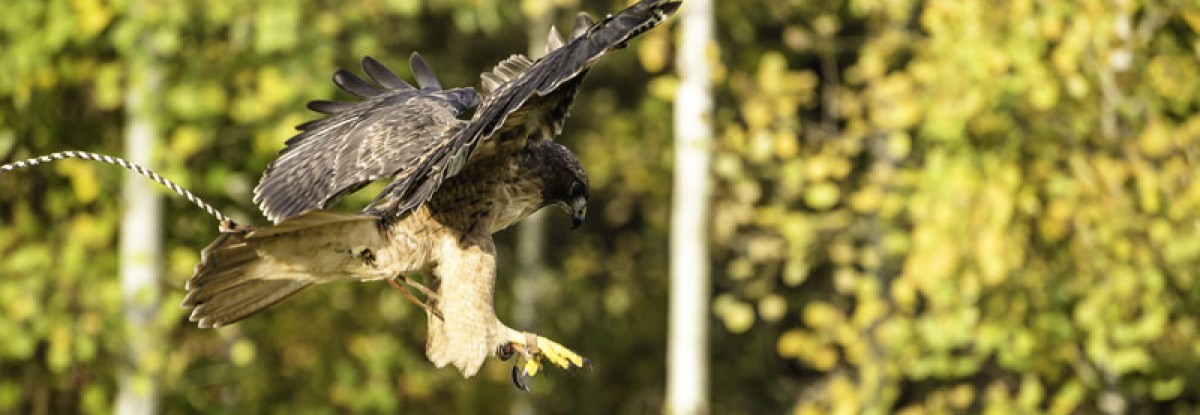Oftentimes owls are seen as elusive, night-hunting birds that we know little about. It’s a special treat to spy one sleeping in a tree or flying in the evening. Wildlife photographers have their secret spots they frequent in the hopes of catching a glimpse of these mysterious birds. Owls are often portrayed as the old and wise bird – a bird whose head can turn an entire 360 degrees, who only call out “hooo hooo,” and who only eat mice at night by using their incredible vision.
How much of this is true? None of it! They really don’t turn their heads 360 degrees contrary to popular belief. Cindy Lefton, one of our clinic volunteers, writes about the (sometimes controversial) Barred Owl:
I encountered my first Barred Owl while volunteering last week at Chintimini Wildlife; and remarkably, I encountered my second Barred Owl that afternoon in my neighbor’s backyard. As I reviewed my volunteer duties for the day, I saw that we had to weigh a Barred Owl. I was not very familiar with this species of owl, other than a few news articles concerning the Northern Spotted Owl. The Barred Owl? Or perhaps, the “Bard owl?” After all, Shakespeare was known for his bird references: “The clamorous owl that nightly hoots.”
When I entered the flight cage, I realized that it wasn’t from Shakespeare, but simply its appearance that inspired its name. Most of its body consists of a series of brown and white spotty patterns, while its chest is off-white with thick, vertical brown stripes, or “bars.” What struck me the most were the eyes. Most owls have yellow eyes, but the Barred’s are dark brown, appearing almost solid black. The owl stands about 20-24 inches tall and does not have noticeable ear tufts (like the Great Horned Owl). After weighing the bird, I let it out of its box into the flight cage. It immediately turned towards me with its wings up over its head and glared at me with those large, black eyes. I was impressed.

As I arrived home from Chintimini, I noticed that I had a text with a photo attachment from a neighbor. Who should be staring at me from the photo? Another Barred Owl! This one was perched only five feet from the back porch; a sleepy-eyed bird who was probably wondering why it was receiving so much quiet attention. I immediately wanted to learn more about this owl.
Worldwide, there are approximately 220 species of owls, according to the National Geographic website. The United States only has 19 species, and Oregon is fortunate to have 14 of these.
Originally from the East Coast, Barred Owls can now be found all over the United States. The species expanded its range to Oregon in the 1970s. Oregon suits them well, because they prefer to live in wooded areas, and only use open areas to hunt. The Barred Owl gained notoriety in the news due to its competition with the threatened Northwest Spotted Owl. The two species look very similar, except that the Barred Owl has thick stripes on its chest, while the Spotted Owl is well, spotted.
What’s That, You Say?
Besides the notable stripe-pattern, the Barred Owl is known for its unique calls. Like many animals, owls don’t have just one sound or call. They vocalize differently depending on the situation (mating, warnings, etc.). But the most recognized Barred Owl call is the “Who cooks for you?” vocalization. They are considered to be more vocal than other owls, so listen carefully—you are more likely to hear one than see one. The good news is that they are not strictly nocturnal birds (only active at night). They are called “crepuscular,” which means they are mostly active at dawn and dusk. On an overcast day (which is often in Oregon), they can be active in the daytime as well. They begin mating in January/February, so now is the ideal time to hear that male owl calling for a mate!
Click here to hear a Barred Owl call.
Don’t Let the Sweet Face Fool You: the Barred is a Serious Predator
The Barred Owl is known to be an efficient predator and is not a picky eater. While it prefers to catch mice and other rodents, they have been seen catching rabbits, foxes, bats, birds, fish, and even the stray house cat. It can be territorial: there have been reports of Barreds swooping down on unsuspecting runners—but this is rare.
This owl is not a migratory bird and if it finds a good place to live—with plenty of food nearby, it might stay in the same location and breed with the same mate year after year. Its only true predator is the Great Horned Owl; and given that it can be found living close to humans, car strikes are a problem. These owls can live to be 24 years old in the wild, which is remarkable.
Yes, the Barred Owl has been controversial in its contributing role to the decline of the Northern Spotted Owl, but I have to admit, the Barred is a beautiful and fascinating bird.




